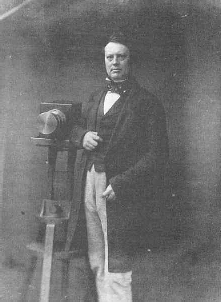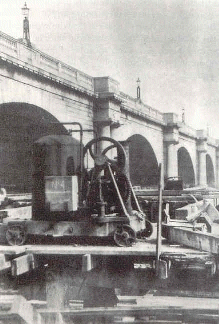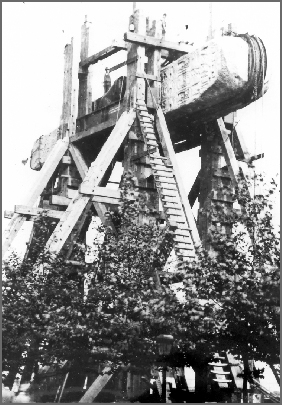
Peter Le Neve-Foster and photography.
Taken from the RSA Journal Vol.CXLII No. 5454 November 1994

The Society of Arts has been described as England's fairy godmother for its benefactions to arts and manufactures in the 19th century, not least for promoting major exhibitions. A celebrated Secretary of the Society, Peter Le Neve-Foster, was associated with many of them, specially where the display of photography was concerned, contributing his considerable expertise as a photographer and writer on photography.
If the legacy of Talbot and Herschel was to leave photography with a sound technical base by their discoveries, with artist photographers like Delamotte applying the training and experience of professional painters to their photography, then an equally effective contribution was provided by photographers like Fry, Fenton and Foster. They were largely responsible for the acceptance of the new invention as a worthy addition to the graphic arts by founding the photographic clubs and societies that promoted the display of photography at exhibitions. These events took place in the decade 1852-1862, a critical and formative period in the history of photography. It saw the founding of the Photographic Society in 1853 by many members of Peter Fry's Photographic Club; and beginning with the Society's 1852 Photographic Exhibition, which was of seminal importance, a run of exhibitions that culminated with the photographic displays at the International Exhibition of 1862. The high quality displays particularly from the newly established commercial studios firmly established the pre-eminence of photography; it could no longer be considered a mere scientific curiosity, the plaything of the dilettante. Foster was closely involved with both these displays and many others; he also contributed to exhibition catalogues, photographic reviews in the Society's Journal and publications such as the British journal of Photography.
Foster was born on 17 August 1809 in Lenwade, Norfolk, of an old East Anglian family, his father also Peter, being a member of the Society. After studying under Dr Valpy at Norwich Grammar School he went up to Cambridge where he was elected a fellow of his college, Trinity Hall, in 1835. He then embarked on a legal career joining the Middle Temple and was called to the Bar in 1836. Interestingly, two other pioneer photographers, Roger Fenton and Peter Fry, were also lawyers. However, Foster gave up his legal practice in conveyancing in 1853, when he succeeded Edward Solly to the prestigious and full-time post of Secretary of the Society of Arts. Another more recent Peter Le Neve-Foster, writing in the journal in 1962, traced the two hundred year association between the Society and the Foster family. This had begun in 1762 with the membership of Abraham Osorio, a Throgmorton Street merchant, who had chaired a meeting that negotiated with the Adam Brothers over the building of the Society's House. The photographer's mother was descended from the Osorios.
Peter himself joined the Society in 1837, proposed for membership by W. H. Bodkin, a judge. He soon became a member of Council being appointed Treasurer for the years 1850 and 1851. Foster was also a Treasurer of the Commission set up by Prince Albert to prepare for the Crystal Palace Exhibition. It came as no surprise, therefore, that he secured the post of Secretary in 1853, even though he was opposed by Robert Hunt, the highly respected writer on science and photography. Among the first measures he took was to arrange a series of touring exhibitions of photographs from the Society's collection, as a sequel to the successful Photographic Exhibition in 1852. The latest examples of photography seen in the capital could thus be displayed in Aberdeen, for example, alongside the work of Scottish photographers.
The Society had played a central role in the holding of industrial exhibitions beginning with William Bayley's Industrial Exhibition of 1761. The following century a Secretary of the Society, Francis Whishaw, held at his own expense, a similar exhibition at the Society. This was followed two years later by John Scott Russell's Industrial Exhibition of 1847, when Antoine Claudet, a glass maker and professional Daguerreotype photographer, displayed his portraits. Scott Russell's Exhibition which included select specimens of British manufactures and the decorative arts, was the first such display in England and a prototype of the Great Exhibition of 1851. The Society was closely involved in its planning, and Foster would have been conversant with the limited photographic displays on show. These had been placed among the Philosophical Instruments, the Fine Arts being excluded altogether from the Exhibition. Nevertheless, the status of photography seems to have undergone a considerable reappraisal by 1857, the year of the Manchester Art Treasures Exhibition. This was entirely devoted to the Fine Arts, with the photographic displays the selection of P. H. Delamotte, hung alongside paintings for the very first time. The Society's Photographic Exhibition of 1852 had largely initiated this change in attitude towards photography.

Detail of Waterloo Bridge taken by Peter Le Neve-Foster on the Thames Embankment near the Society's House.
The Society and its photographer members led by Foster had continued to exercise its innovative function by staging the Photographic Exhibition of December 1852. The first public display of its kind held in England it demonstrated the significance and potential of the photographic invention by showing outstanding examples of photography. No longer could it be thought merely a sketching aid to the painter which because of its chemical and mechanical nature left little creativity to the artist. The setting for the Exhibition, The Great Room of the Society, was also significant. William Shipley, a drawing master, had founded a Society that encouraged young artists by awarding prizes, and that held regular exhibitions of paintings. Therefore the Society was the ideal forum for the promotion of photography as an art form. A soiree opened the Exhibition to critical acclaim. The artistic firmament was seen as acquiring a new star which appeared in magical fashion, like a glistening print emerging from the dark room of science. A report in the Journal likely to have been written by Foster himself gave credit to Cundall, Delamotte and Fenton, for the valuable assistance they have rendered in procuring specimens and in arranging them in the rooms of the Society. Foster collaborated with Edward Solly to assemble the displays, Fox Talbot being among the large numbers of amateurs invited to contribute their pictures.
The Talbot positive negative discovery with its improved variant the Archer Collodion process were British inventions, and it was fitting therefore that this key aspect of the discovery should comprise all the displays. However, the Illustrated London News voiced its disapproval at the omission of the Daguerreotype. Foster himself experimented with some of the positive negative processes shown including the Le Gray waxpaper, which was favoured by Newton and Fry. But the highlight of the displays were the prints taken on the Scott Archer Collodion Negative which had only been discovered the previous year. By its superb definition, precision, clarity and ability to show good half tonal effects it revolutionised photography. Foster later described how the 'simplicity of the process and beauty of the results caused its almost universal adoption'. Delamotte, Home and Berger showed examples of this process.
The Society was even more closely involved in the planning of the 1862 International Exhibition than it had been with the Crystal Palace. Considered a sequel to that Exhibition, it was held in South Kensington but sadly was largely overshadowed by the tragic death of Prince Albert. Despite the dull buildings of Captain Fawkes, it was not the financial failure of the earlier New York, Paris or Dublin Exhibitions, due to the excellence of the displays. Foster was Secretary of the Department of Photography Section XIV of the Exhibitions, selecting the photographs with colleagues from the Photographic Society. The early promise of the commercial viability of photography was now fully realised by hundreds of fine displays shown by the commercial studios.
Among the celebrated portrait firms were those of Maull and Polyblank, H. N. King, Herbert Watkins, J. E. Mayall, Claudet and Bassano. They showed examples of cabinet portraits and the smaller and cheaper carte de visite which filled many a Victorian album, often illustrating successfully how photography could capture the essence of a sitter's personality, surely the purpose of portraiture. Sir William Ross had warned of the demise of his ancient profession of miniature painting at the introduction of photography. Sadly these forebodings were proved only too true by 1862; some miniaturists were even reduced, somewhat pathetically, to colouring the sepia photographic portraits, with results that were not entirely unsuccessful.
The landscape studios also had extensive displays and were represented by such firms as W. R. Sedgfield and G.W.Wilson which displayed urban and rural scenes. Wilson specialised in well composed picturesque views which depicted the more dramatic elements of the landscape as found in Wales and Scotland, with lakeside, river and mountainous scenery shown to best advantage in three dimensional stereoscopic photography, the invention of Sir David Brewster. Foster lived to see the introduction of faster exposure times and improved printing techniques which led to the pictorial landscape photography of Davison and Emerson who employed a more atmospheric approach to the landscape, making full use of cloud effects denied to early photographers.
The absolute fidelity of the lens made photography ideally suited to copying and recording works of art, be it sculpture, drawing, painting or engraving. This ability to reproduce accurately was considered so important that in a paper to the Society on printmaking S. T. Davenport described photography somewhat dismissively as 'in the main a copying process'. The value of this aspect of photography was recognised at the Exhibition, with a large number of displays of art objects for which there were specialist photographers. J. B. Pyne,J. Caldesi and Charles Thurston Thompson showed photographs of antique china vases, the Raphael cartoons and old master drawings, Caldesi specialising in the photography of portrait miniatures. Foster selected the unusual among the photographs displayed: Herbert Watkins showed the dissected brain of a chimpanzee, Robert Cade images of heavy machinery, and there were examples of enlargements by 'solar camera'. Antoine Claudet displayed such a portrait enlargement, that of his old friend and fellow member of the Society, Peter Le Neve-Foster. Foster himself only showed one picture, his view of Battersea Suspension Bridge, taken on turpentine wax paper. No examples of this image appear to have survived.
In his preface to the Exhibition Catalogue Foster dealt with the problem of fading to which the nitrate of silver prints then in general use were prone. However, more permanent printing processes were being developed and these were displayed. John Pouncey showed his direct printing in carbon process and Talbot displayed his photographically etched plates that could print like conventional engravings. Also included was the electrotype invention of Paul Pretsch.
Foster never abandoned his cherished pastime and a family collection includes his early photographs of Bodiam Castle; among other country views and architectural scenes are views of Kew Gardens.

Cleopatra's Needle being erected, taken by Peter Le Neve-Foster on the Thames Embankment.
Both the photo of Cleopatra's Needle and that of Waterloo Bridge were taken on the Thames Embankment near the Society's House. These are competent pictures and Foster, the true enthusiast, obviously derived as much pleasure from taking and printing his photographs as from admiring the end result. The picture of the erection of Cleopatra's Needle is a good example of documentary photography; the view of his children boating on the Black Sea, the lake in Wandsworth Common near his house, perhaps his most charming study.
By the time of Foster's death in 1879 the membership of the Society had increased threefold since he became Secretary which gives some measure of his success; his contribution to photography while still not fully recognised, is just as significant.
NOTES
1. Obituary,Jnl S of A, 28 February 1879.
2. 'The Le Neves of Norfolk', Peter Le Neve Foster, MA, ARPS, FRSA 1969.
3. Peter Le Neve Foster, Jnl S of A, Vol CX, May 1962.
4. Trueman Wood, Sir Henry, A History of the Royal Society of Arts, John Murray, 1913.
5. Luckhurst, Kenneth W., The Story of Exhibitions, 1951.
6. Exhibition of the Works of Industry of All Nations, Reports by the Juries, 1852.
7. The Society of Arts Photographic Exhibition of 18 52; Jnl S of A, Vol CXXXI, December 1982, P.54.
8. International Exhibition of 1 862, Catalogue of Photographs, Class XIV.
9. S. T .Davenport, on Prints and their Production, Jnl S of A, Vol XVIll, 10 December 1869.
10. International Exhibition of 1862 Catalogue of Photographs, Class XIV, P.3.